Analysis of Children's Interactions and Development (6-15)
VerifiedAdded on 2023/06/03
|8
|2189
|322
Report
AI Summary
This report delves into the social interactions and developmental stages of children aged 6 to 15, drawing upon observations and interviews with educators. It explores how peer influence and play contribute to healthy child growth, examining the different types of games and interactions observed across various age groups. The study highlights the impact of social backgrounds, co-curricular activities, and teaching methods on student behavior and learning. Furthermore, the report investigates how children learn through observation, language development, and their interactions within school settings. It emphasizes the importance of play in cognitive, physical, and emotional development, alongside the roles of teachers and parents in fostering positive behaviors and encouraging children's overall well-being. The conclusion underscores the need for parental and teacher involvement in guiding children toward self-discipline and understanding societal norms, ultimately contributing to the child's overall development.
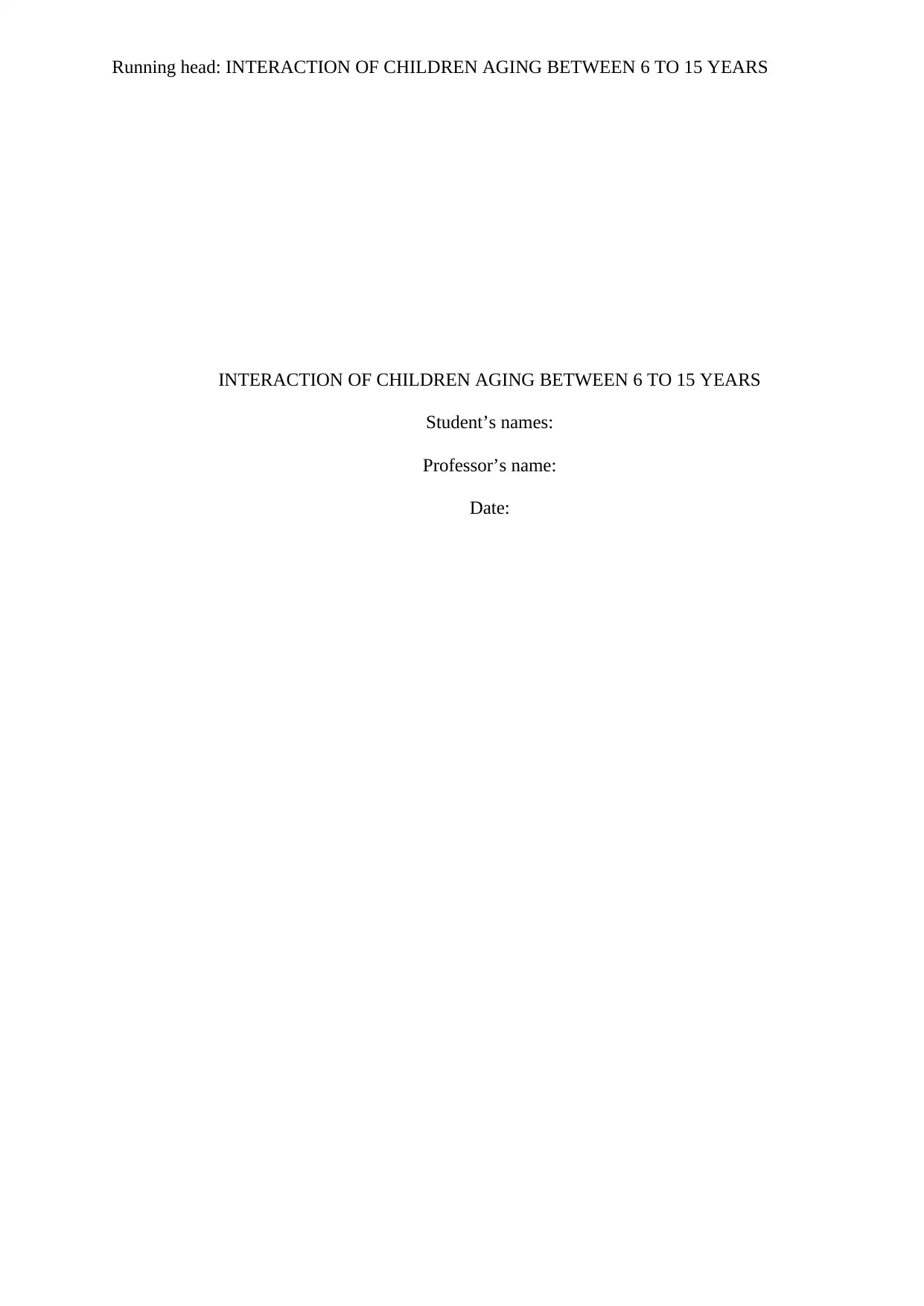
Running head: INTERACTION OF CHILDREN AGING BETWEEN 6 TO 15 YEARS
INTERACTION OF CHILDREN AGING BETWEEN 6 TO 15 YEARS
Student’s names:
Professor’s name:
Date:
INTERACTION OF CHILDREN AGING BETWEEN 6 TO 15 YEARS
Student’s names:
Professor’s name:
Date:
Paraphrase This Document
Need a fresh take? Get an instant paraphrase of this document with our AI Paraphraser
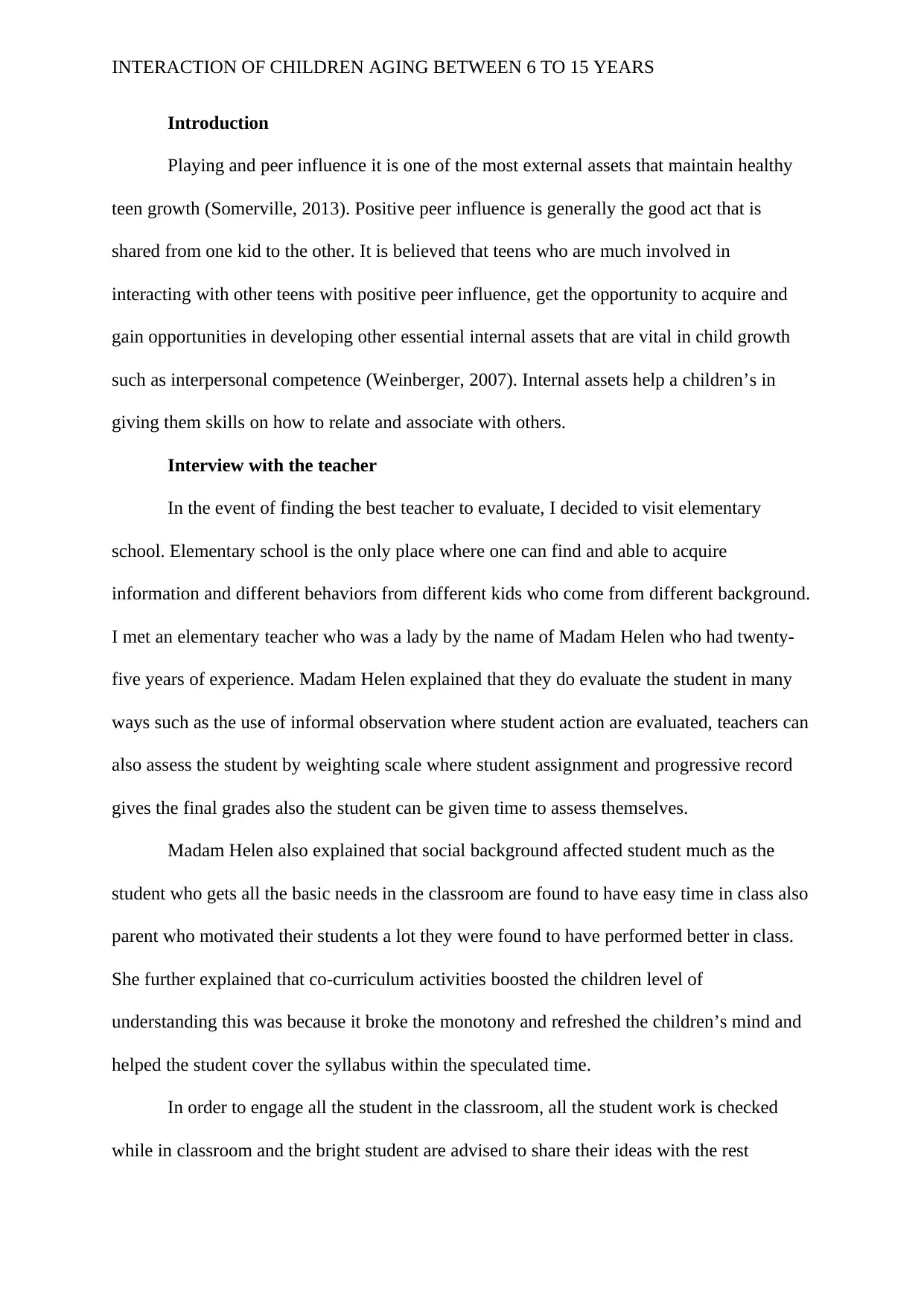
INTERACTION OF CHILDREN AGING BETWEEN 6 TO 15 YEARS
Introduction
Playing and peer influence it is one of the most external assets that maintain healthy
teen growth (Somerville, 2013). Positive peer influence is generally the good act that is
shared from one kid to the other. It is believed that teens who are much involved in
interacting with other teens with positive peer influence, get the opportunity to acquire and
gain opportunities in developing other essential internal assets that are vital in child growth
such as interpersonal competence (Weinberger, 2007). Internal assets help a children’s in
giving them skills on how to relate and associate with others.
Interview with the teacher
In the event of finding the best teacher to evaluate, I decided to visit elementary
school. Elementary school is the only place where one can find and able to acquire
information and different behaviors from different kids who come from different background.
I met an elementary teacher who was a lady by the name of Madam Helen who had twenty-
five years of experience. Madam Helen explained that they do evaluate the student in many
ways such as the use of informal observation where student action are evaluated, teachers can
also assess the student by weighting scale where student assignment and progressive record
gives the final grades also the student can be given time to assess themselves.
Madam Helen also explained that social background affected student much as the
student who gets all the basic needs in the classroom are found to have easy time in class also
parent who motivated their students a lot they were found to have performed better in class.
She further explained that co-curriculum activities boosted the children level of
understanding this was because it broke the monotony and refreshed the children’s mind and
helped the student cover the syllabus within the speculated time.
In order to engage all the student in the classroom, all the student work is checked
while in classroom and the bright student are advised to share their ideas with the rest
Introduction
Playing and peer influence it is one of the most external assets that maintain healthy
teen growth (Somerville, 2013). Positive peer influence is generally the good act that is
shared from one kid to the other. It is believed that teens who are much involved in
interacting with other teens with positive peer influence, get the opportunity to acquire and
gain opportunities in developing other essential internal assets that are vital in child growth
such as interpersonal competence (Weinberger, 2007). Internal assets help a children’s in
giving them skills on how to relate and associate with others.
Interview with the teacher
In the event of finding the best teacher to evaluate, I decided to visit elementary
school. Elementary school is the only place where one can find and able to acquire
information and different behaviors from different kids who come from different background.
I met an elementary teacher who was a lady by the name of Madam Helen who had twenty-
five years of experience. Madam Helen explained that they do evaluate the student in many
ways such as the use of informal observation where student action are evaluated, teachers can
also assess the student by weighting scale where student assignment and progressive record
gives the final grades also the student can be given time to assess themselves.
Madam Helen also explained that social background affected student much as the
student who gets all the basic needs in the classroom are found to have easy time in class also
parent who motivated their students a lot they were found to have performed better in class.
She further explained that co-curriculum activities boosted the children level of
understanding this was because it broke the monotony and refreshed the children’s mind and
helped the student cover the syllabus within the speculated time.
In order to engage all the student in the classroom, all the student work is checked
while in classroom and the bright student are advised to share their ideas with the rest
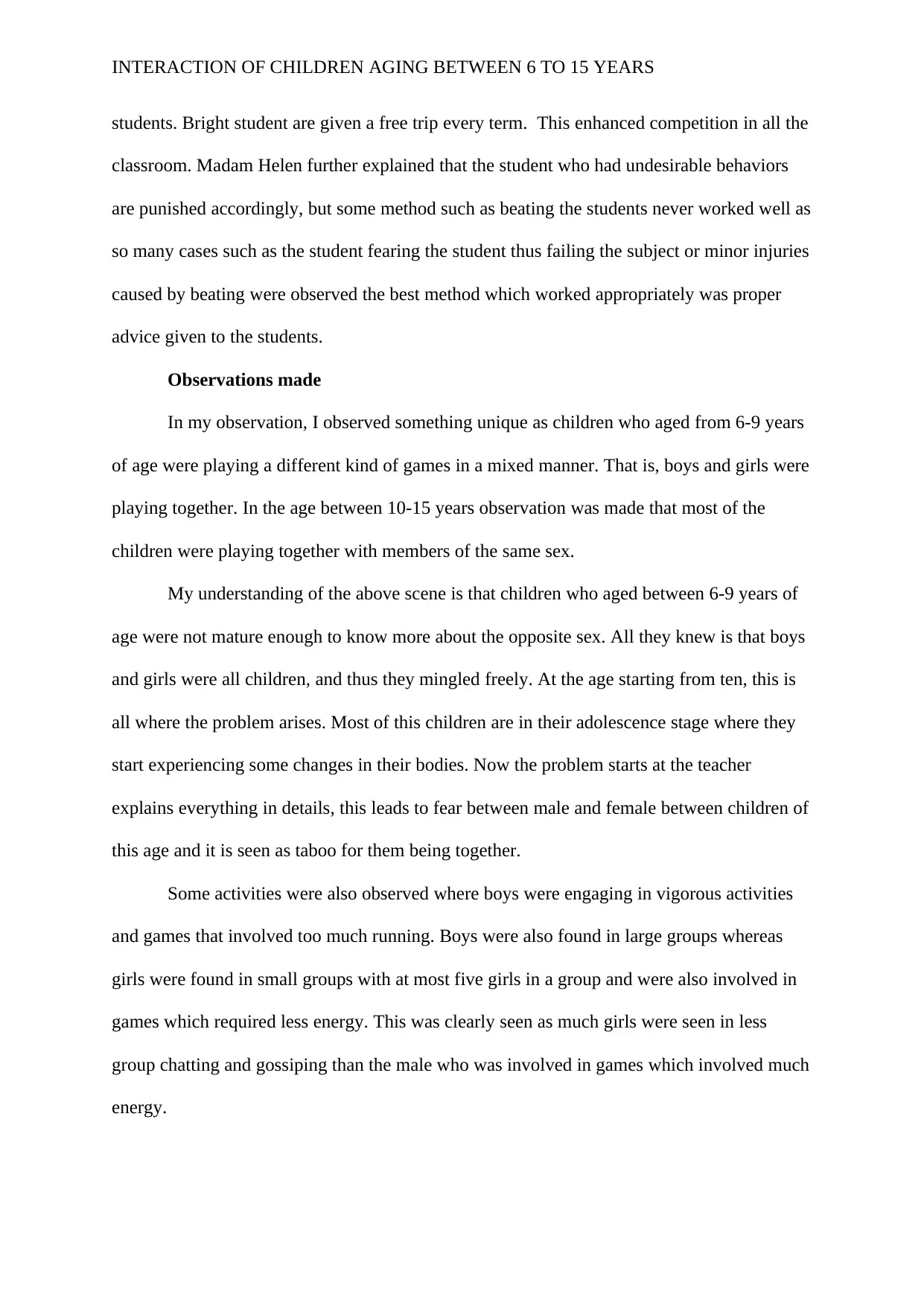
INTERACTION OF CHILDREN AGING BETWEEN 6 TO 15 YEARS
students. Bright student are given a free trip every term. This enhanced competition in all the
classroom. Madam Helen further explained that the student who had undesirable behaviors
are punished accordingly, but some method such as beating the students never worked well as
so many cases such as the student fearing the student thus failing the subject or minor injuries
caused by beating were observed the best method which worked appropriately was proper
advice given to the students.
Observations made
In my observation, I observed something unique as children who aged from 6-9 years
of age were playing a different kind of games in a mixed manner. That is, boys and girls were
playing together. In the age between 10-15 years observation was made that most of the
children were playing together with members of the same sex.
My understanding of the above scene is that children who aged between 6-9 years of
age were not mature enough to know more about the opposite sex. All they knew is that boys
and girls were all children, and thus they mingled freely. At the age starting from ten, this is
all where the problem arises. Most of this children are in their adolescence stage where they
start experiencing some changes in their bodies. Now the problem starts at the teacher
explains everything in details, this leads to fear between male and female between children of
this age and it is seen as taboo for them being together.
Some activities were also observed where boys were engaging in vigorous activities
and games that involved too much running. Boys were also found in large groups whereas
girls were found in small groups with at most five girls in a group and were also involved in
games which required less energy. This was clearly seen as much girls were seen in less
group chatting and gossiping than the male who was involved in games which involved much
energy.
students. Bright student are given a free trip every term. This enhanced competition in all the
classroom. Madam Helen further explained that the student who had undesirable behaviors
are punished accordingly, but some method such as beating the students never worked well as
so many cases such as the student fearing the student thus failing the subject or minor injuries
caused by beating were observed the best method which worked appropriately was proper
advice given to the students.
Observations made
In my observation, I observed something unique as children who aged from 6-9 years
of age were playing a different kind of games in a mixed manner. That is, boys and girls were
playing together. In the age between 10-15 years observation was made that most of the
children were playing together with members of the same sex.
My understanding of the above scene is that children who aged between 6-9 years of
age were not mature enough to know more about the opposite sex. All they knew is that boys
and girls were all children, and thus they mingled freely. At the age starting from ten, this is
all where the problem arises. Most of this children are in their adolescence stage where they
start experiencing some changes in their bodies. Now the problem starts at the teacher
explains everything in details, this leads to fear between male and female between children of
this age and it is seen as taboo for them being together.
Some activities were also observed where boys were engaging in vigorous activities
and games that involved too much running. Boys were also found in large groups whereas
girls were found in small groups with at most five girls in a group and were also involved in
games which required less energy. This was clearly seen as much girls were seen in less
group chatting and gossiping than the male who was involved in games which involved much
energy.
⊘ This is a preview!⊘
Do you want full access?
Subscribe today to unlock all pages.

Trusted by 1+ million students worldwide
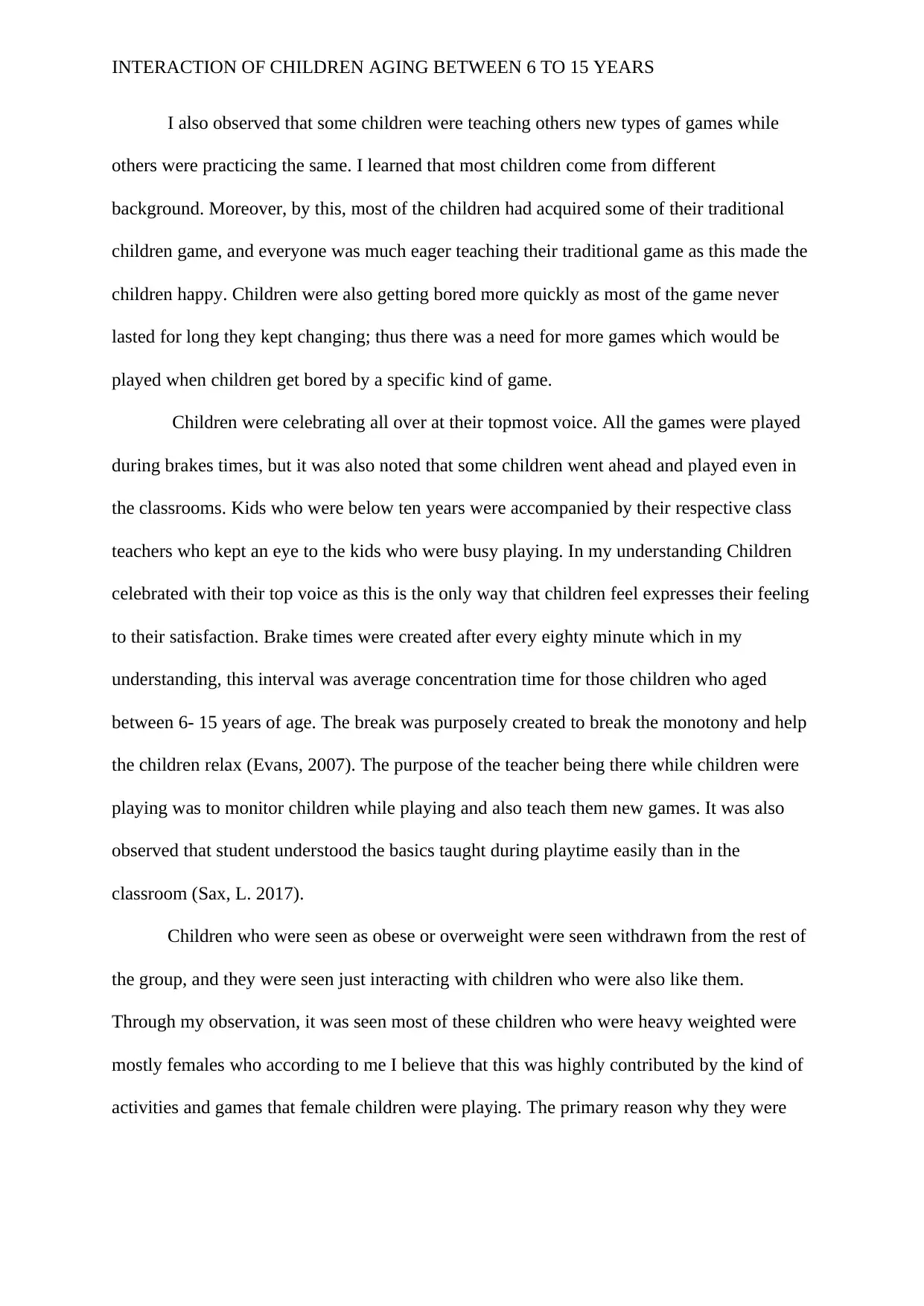
INTERACTION OF CHILDREN AGING BETWEEN 6 TO 15 YEARS
I also observed that some children were teaching others new types of games while
others were practicing the same. I learned that most children come from different
background. Moreover, by this, most of the children had acquired some of their traditional
children game, and everyone was much eager teaching their traditional game as this made the
children happy. Children were also getting bored more quickly as most of the game never
lasted for long they kept changing; thus there was a need for more games which would be
played when children get bored by a specific kind of game.
Children were celebrating all over at their topmost voice. All the games were played
during brakes times, but it was also noted that some children went ahead and played even in
the classrooms. Kids who were below ten years were accompanied by their respective class
teachers who kept an eye to the kids who were busy playing. In my understanding Children
celebrated with their top voice as this is the only way that children feel expresses their feeling
to their satisfaction. Brake times were created after every eighty minute which in my
understanding, this interval was average concentration time for those children who aged
between 6- 15 years of age. The break was purposely created to break the monotony and help
the children relax (Evans, 2007). The purpose of the teacher being there while children were
playing was to monitor children while playing and also teach them new games. It was also
observed that student understood the basics taught during playtime easily than in the
classroom (Sax, L. 2017).
Children who were seen as obese or overweight were seen withdrawn from the rest of
the group, and they were seen just interacting with children who were also like them.
Through my observation, it was seen most of these children who were heavy weighted were
mostly females who according to me I believe that this was highly contributed by the kind of
activities and games that female children were playing. The primary reason why they were
I also observed that some children were teaching others new types of games while
others were practicing the same. I learned that most children come from different
background. Moreover, by this, most of the children had acquired some of their traditional
children game, and everyone was much eager teaching their traditional game as this made the
children happy. Children were also getting bored more quickly as most of the game never
lasted for long they kept changing; thus there was a need for more games which would be
played when children get bored by a specific kind of game.
Children were celebrating all over at their topmost voice. All the games were played
during brakes times, but it was also noted that some children went ahead and played even in
the classrooms. Kids who were below ten years were accompanied by their respective class
teachers who kept an eye to the kids who were busy playing. In my understanding Children
celebrated with their top voice as this is the only way that children feel expresses their feeling
to their satisfaction. Brake times were created after every eighty minute which in my
understanding, this interval was average concentration time for those children who aged
between 6- 15 years of age. The break was purposely created to break the monotony and help
the children relax (Evans, 2007). The purpose of the teacher being there while children were
playing was to monitor children while playing and also teach them new games. It was also
observed that student understood the basics taught during playtime easily than in the
classroom (Sax, L. 2017).
Children who were seen as obese or overweight were seen withdrawn from the rest of
the group, and they were seen just interacting with children who were also like them.
Through my observation, it was seen most of these children who were heavy weighted were
mostly females who according to me I believe that this was highly contributed by the kind of
activities and games that female children were playing. The primary reason why they were
Paraphrase This Document
Need a fresh take? Get an instant paraphrase of this document with our AI Paraphraser
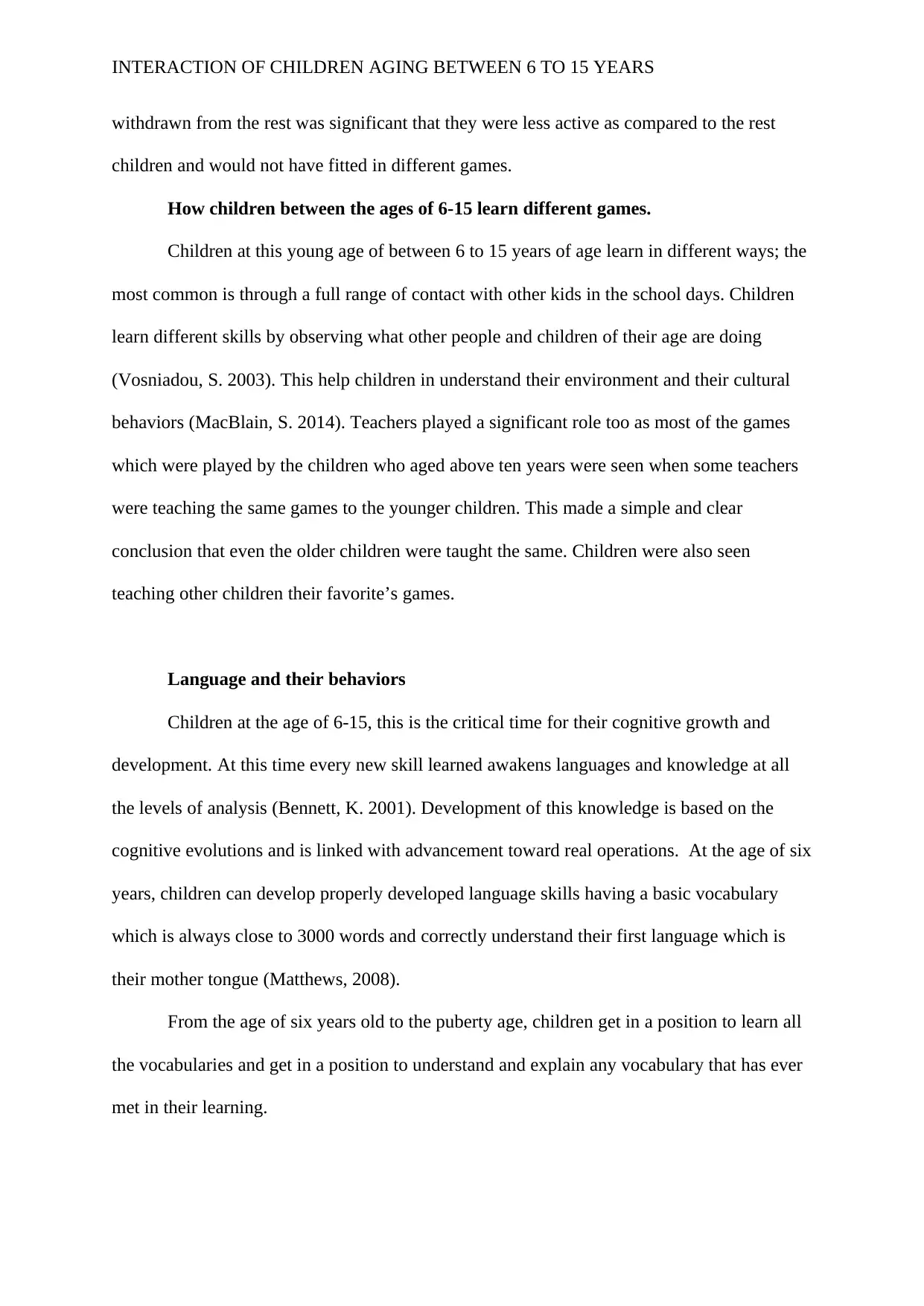
INTERACTION OF CHILDREN AGING BETWEEN 6 TO 15 YEARS
withdrawn from the rest was significant that they were less active as compared to the rest
children and would not have fitted in different games.
How children between the ages of 6-15 learn different games.
Children at this young age of between 6 to 15 years of age learn in different ways; the
most common is through a full range of contact with other kids in the school days. Children
learn different skills by observing what other people and children of their age are doing
(Vosniadou, S. 2003). This help children in understand their environment and their cultural
behaviors (MacBlain, S. 2014). Teachers played a significant role too as most of the games
which were played by the children who aged above ten years were seen when some teachers
were teaching the same games to the younger children. This made a simple and clear
conclusion that even the older children were taught the same. Children were also seen
teaching other children their favorite’s games.
Language and their behaviors
Children at the age of 6-15, this is the critical time for their cognitive growth and
development. At this time every new skill learned awakens languages and knowledge at all
the levels of analysis (Bennett, K. 2001). Development of this knowledge is based on the
cognitive evolutions and is linked with advancement toward real operations. At the age of six
years, children can develop properly developed language skills having a basic vocabulary
which is always close to 3000 words and correctly understand their first language which is
their mother tongue (Matthews, 2008).
From the age of six years old to the puberty age, children get in a position to learn all
the vocabularies and get in a position to understand and explain any vocabulary that has ever
met in their learning.
withdrawn from the rest was significant that they were less active as compared to the rest
children and would not have fitted in different games.
How children between the ages of 6-15 learn different games.
Children at this young age of between 6 to 15 years of age learn in different ways; the
most common is through a full range of contact with other kids in the school days. Children
learn different skills by observing what other people and children of their age are doing
(Vosniadou, S. 2003). This help children in understand their environment and their cultural
behaviors (MacBlain, S. 2014). Teachers played a significant role too as most of the games
which were played by the children who aged above ten years were seen when some teachers
were teaching the same games to the younger children. This made a simple and clear
conclusion that even the older children were taught the same. Children were also seen
teaching other children their favorite’s games.
Language and their behaviors
Children at the age of 6-15, this is the critical time for their cognitive growth and
development. At this time every new skill learned awakens languages and knowledge at all
the levels of analysis (Bennett, K. 2001). Development of this knowledge is based on the
cognitive evolutions and is linked with advancement toward real operations. At the age of six
years, children can develop properly developed language skills having a basic vocabulary
which is always close to 3000 words and correctly understand their first language which is
their mother tongue (Matthews, 2008).
From the age of six years old to the puberty age, children get in a position to learn all
the vocabularies and get in a position to understand and explain any vocabulary that has ever
met in their learning.
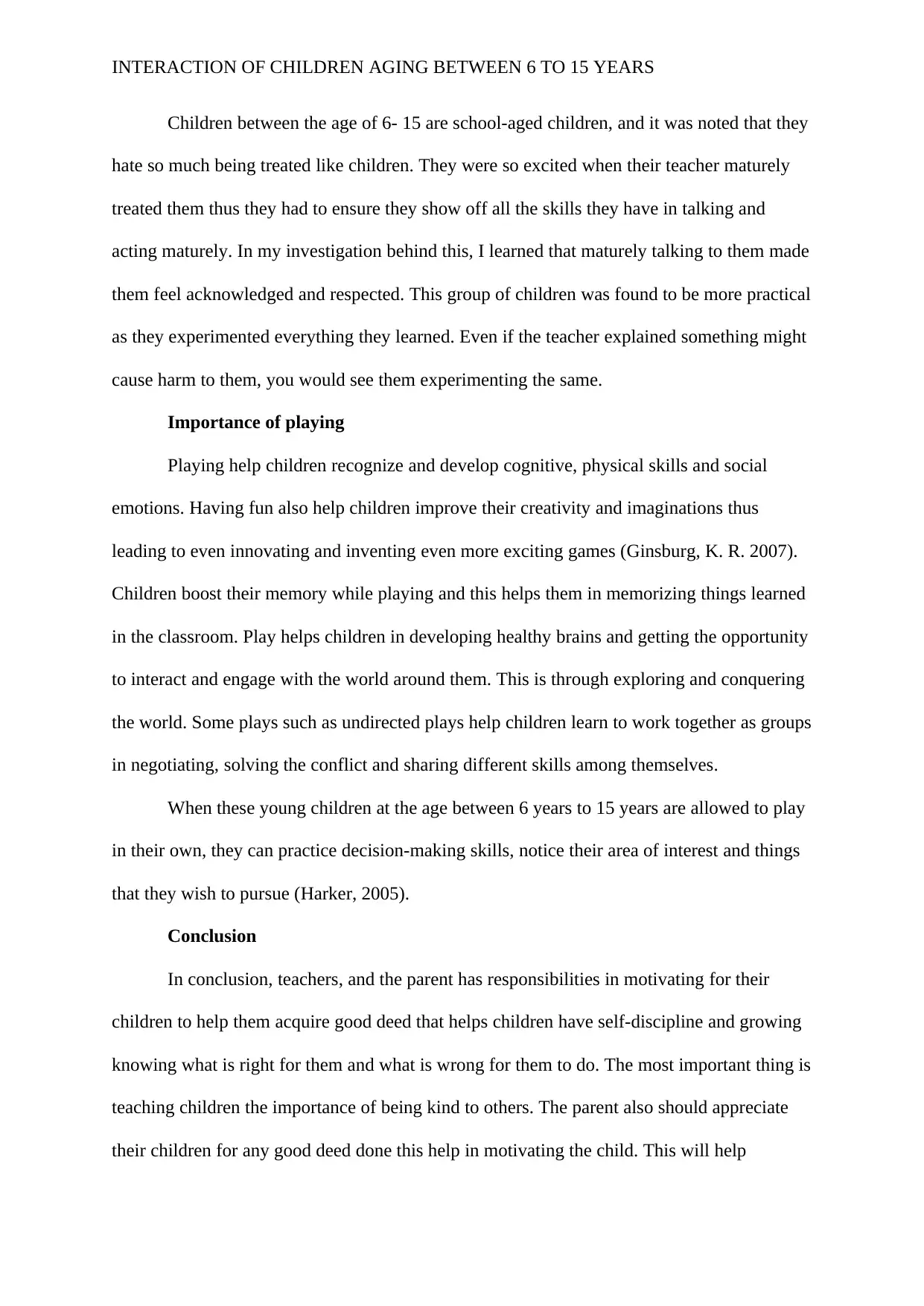
INTERACTION OF CHILDREN AGING BETWEEN 6 TO 15 YEARS
Children between the age of 6- 15 are school-aged children, and it was noted that they
hate so much being treated like children. They were so excited when their teacher maturely
treated them thus they had to ensure they show off all the skills they have in talking and
acting maturely. In my investigation behind this, I learned that maturely talking to them made
them feel acknowledged and respected. This group of children was found to be more practical
as they experimented everything they learned. Even if the teacher explained something might
cause harm to them, you would see them experimenting the same.
Importance of playing
Playing help children recognize and develop cognitive, physical skills and social
emotions. Having fun also help children improve their creativity and imaginations thus
leading to even innovating and inventing even more exciting games (Ginsburg, K. R. 2007).
Children boost their memory while playing and this helps them in memorizing things learned
in the classroom. Play helps children in developing healthy brains and getting the opportunity
to interact and engage with the world around them. This is through exploring and conquering
the world. Some plays such as undirected plays help children learn to work together as groups
in negotiating, solving the conflict and sharing different skills among themselves.
When these young children at the age between 6 years to 15 years are allowed to play
in their own, they can practice decision-making skills, notice their area of interest and things
that they wish to pursue (Harker, 2005).
Conclusion
In conclusion, teachers, and the parent has responsibilities in motivating for their
children to help them acquire good deed that helps children have self-discipline and growing
knowing what is right for them and what is wrong for them to do. The most important thing is
teaching children the importance of being kind to others. The parent also should appreciate
their children for any good deed done this help in motivating the child. This will help
Children between the age of 6- 15 are school-aged children, and it was noted that they
hate so much being treated like children. They were so excited when their teacher maturely
treated them thus they had to ensure they show off all the skills they have in talking and
acting maturely. In my investigation behind this, I learned that maturely talking to them made
them feel acknowledged and respected. This group of children was found to be more practical
as they experimented everything they learned. Even if the teacher explained something might
cause harm to them, you would see them experimenting the same.
Importance of playing
Playing help children recognize and develop cognitive, physical skills and social
emotions. Having fun also help children improve their creativity and imaginations thus
leading to even innovating and inventing even more exciting games (Ginsburg, K. R. 2007).
Children boost their memory while playing and this helps them in memorizing things learned
in the classroom. Play helps children in developing healthy brains and getting the opportunity
to interact and engage with the world around them. This is through exploring and conquering
the world. Some plays such as undirected plays help children learn to work together as groups
in negotiating, solving the conflict and sharing different skills among themselves.
When these young children at the age between 6 years to 15 years are allowed to play
in their own, they can practice decision-making skills, notice their area of interest and things
that they wish to pursue (Harker, 2005).
Conclusion
In conclusion, teachers, and the parent has responsibilities in motivating for their
children to help them acquire good deed that helps children have self-discipline and growing
knowing what is right for them and what is wrong for them to do. The most important thing is
teaching children the importance of being kind to others. The parent also should appreciate
their children for any good deed done this help in motivating the child. This will help
⊘ This is a preview!⊘
Do you want full access?
Subscribe today to unlock all pages.

Trusted by 1+ million students worldwide

INTERACTION OF CHILDREN AGING BETWEEN 6 TO 15 YEARS
children grow to know about life and the proper relationship between different members of
society. This will automatically change the phase of the country.
children grow to know about life and the proper relationship between different members of
society. This will automatically change the phase of the country.
Paraphrase This Document
Need a fresh take? Get an instant paraphrase of this document with our AI Paraphraser
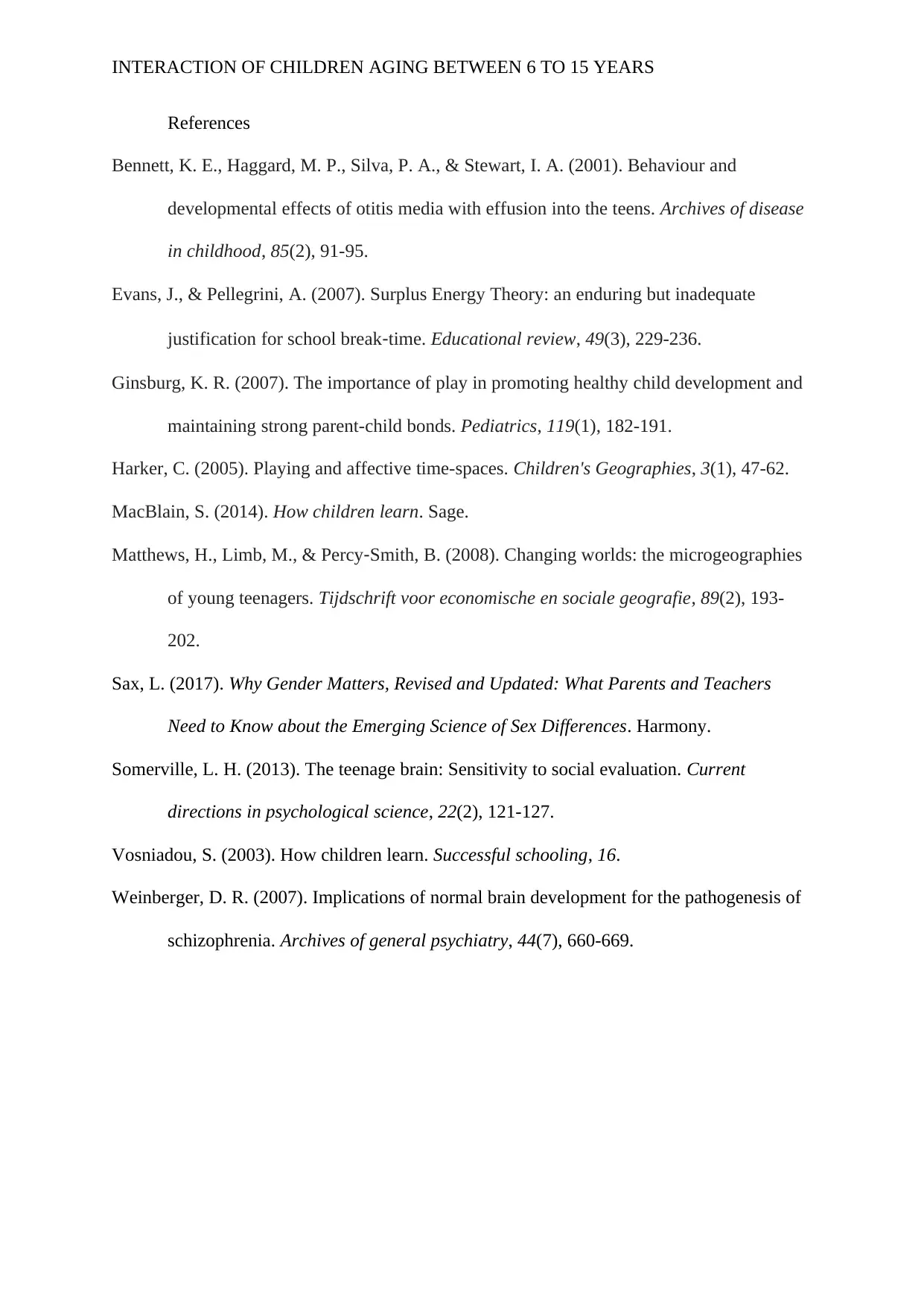
INTERACTION OF CHILDREN AGING BETWEEN 6 TO 15 YEARS
References
Bennett, K. E., Haggard, M. P., Silva, P. A., & Stewart, I. A. (2001). Behaviour and
developmental effects of otitis media with effusion into the teens. Archives of disease
in childhood, 85(2), 91-95.
Evans, J., & Pellegrini, A. (2007). Surplus Energy Theory: an enduring but inadequate
justification for school break‐time. Educational review, 49(3), 229-236.
Ginsburg, K. R. (2007). The importance of play in promoting healthy child development and
maintaining strong parent-child bonds. Pediatrics, 119(1), 182-191.
Harker, C. (2005). Playing and affective time-spaces. Children's Geographies, 3(1), 47-62.
MacBlain, S. (2014). How children learn. Sage.
Matthews, H., Limb, M., & Percy‐Smith, B. (2008). Changing worlds: the microgeographies
of young teenagers. Tijdschrift voor economische en sociale geografie, 89(2), 193-
202.
Sax, L. (2017). Why Gender Matters, Revised and Updated: What Parents and Teachers
Need to Know about the Emerging Science of Sex Differences. Harmony.
Somerville, L. H. (2013). The teenage brain: Sensitivity to social evaluation. Current
directions in psychological science, 22(2), 121-127.
Vosniadou, S. (2003). How children learn. Successful schooling, 16.
Weinberger, D. R. (2007). Implications of normal brain development for the pathogenesis of
schizophrenia. Archives of general psychiatry, 44(7), 660-669.
References
Bennett, K. E., Haggard, M. P., Silva, P. A., & Stewart, I. A. (2001). Behaviour and
developmental effects of otitis media with effusion into the teens. Archives of disease
in childhood, 85(2), 91-95.
Evans, J., & Pellegrini, A. (2007). Surplus Energy Theory: an enduring but inadequate
justification for school break‐time. Educational review, 49(3), 229-236.
Ginsburg, K. R. (2007). The importance of play in promoting healthy child development and
maintaining strong parent-child bonds. Pediatrics, 119(1), 182-191.
Harker, C. (2005). Playing and affective time-spaces. Children's Geographies, 3(1), 47-62.
MacBlain, S. (2014). How children learn. Sage.
Matthews, H., Limb, M., & Percy‐Smith, B. (2008). Changing worlds: the microgeographies
of young teenagers. Tijdschrift voor economische en sociale geografie, 89(2), 193-
202.
Sax, L. (2017). Why Gender Matters, Revised and Updated: What Parents and Teachers
Need to Know about the Emerging Science of Sex Differences. Harmony.
Somerville, L. H. (2013). The teenage brain: Sensitivity to social evaluation. Current
directions in psychological science, 22(2), 121-127.
Vosniadou, S. (2003). How children learn. Successful schooling, 16.
Weinberger, D. R. (2007). Implications of normal brain development for the pathogenesis of
schizophrenia. Archives of general psychiatry, 44(7), 660-669.
1 out of 8
Related Documents
Your All-in-One AI-Powered Toolkit for Academic Success.
+13062052269
info@desklib.com
Available 24*7 on WhatsApp / Email
![[object Object]](/_next/static/media/star-bottom.7253800d.svg)
Unlock your academic potential
Copyright © 2020–2025 A2Z Services. All Rights Reserved. Developed and managed by ZUCOL.





